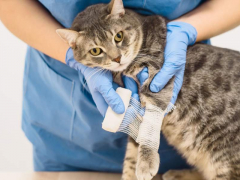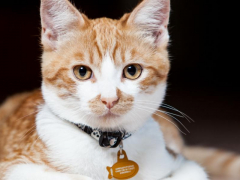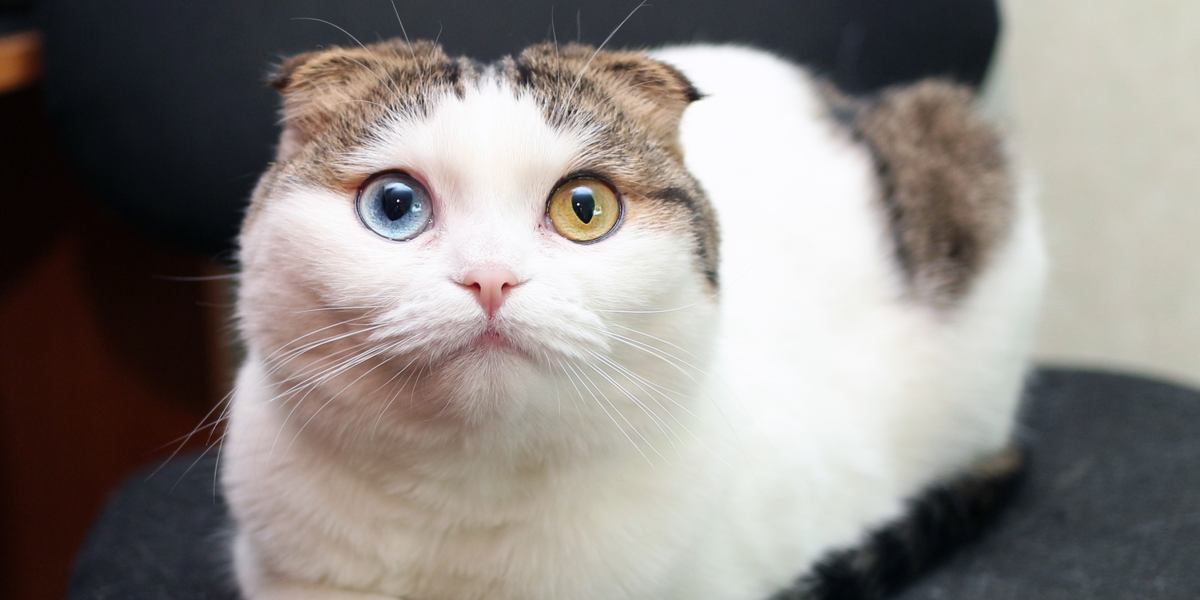
Cats come in all shapes and sizes, coat types and coat colors but did you know that there are many different types of eye color in cats?
What Color Eyes Can Cats Have?
You may have noticed amazing blues, yellows and greens in the eyes of our feline friends but there are many other colors to watch out for. Some eye colors may be related to certain health conditions, pedigree breeds or it might just be a unique random occurrence.
We’ll discuss eye colors and how they occur in more detail now.
Structure Of The Eye
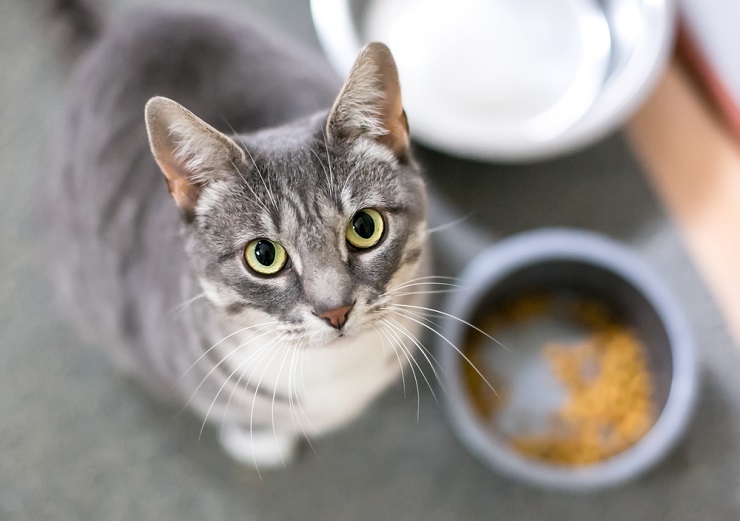
In order to discuss the types of eye color in cats, it’s important to know where this color is in the eye. Color is present in the iris, which is a pigmented band surrounding the pupil in a cat’s eyeball.
It’s responsible for controlling the size of the pupil, hence the amount of light that reaches the back of the eye.
The iris is made up of two layers, the front part which is the stroma and behind that, the epithelial cell layer. Pigment (or lack of pigment) in the iris is what accounts for eye color in cats (and humans!).
Iris Color

We’ve established that the color we see in cat’s eyes is present in the iris of the eye. But what makes the iris colored? How do we get different eye colors?
Pigment or color, is made by melanocytes that are present in the iris. Melanocytes are cells that produce melanin. Melanin is a pigment producing cell that accounts for color in our eyes, hair and coat and the same goes for cats. The more melanin you produce and the more active the cells are the darker and more intense the colors will be. For example; a cat that produces a lot of melanin may have a darker eye color like copper.
True Eye Color
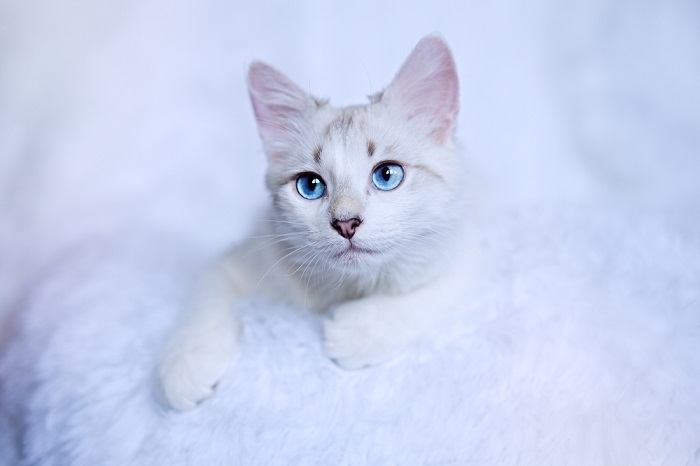
Cats aren’t necessarily born with their true, permanent eye color. Kittens are born with their eyes closed and these open around 8-12 days of age. They have blue eyes until about 6 weeks when the iris color starts to change to develop the cat’s permanent eye color.
Also Read: When Do Kittens Open Their Eyes? Kitten Eye Development Explained
Kittens usually develop their permanent eye color by 3-4 months of age. This can be a helpful tool to age a kitten if you don’t know its age.
The Different Types Eye Of Colors in Cats
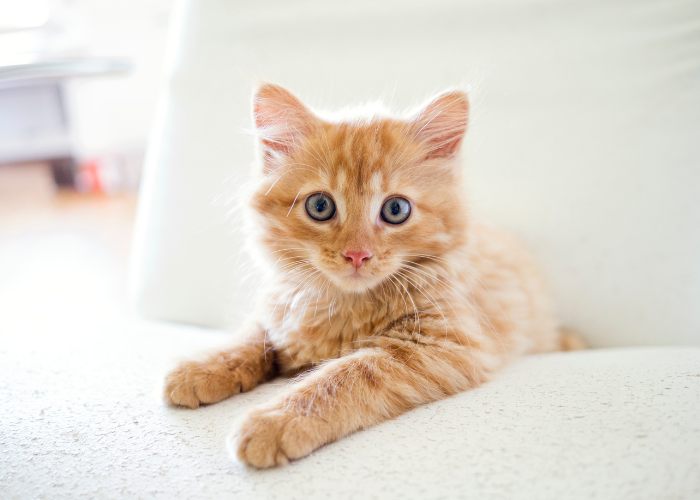
Now that we know where the color is in the eye (iris) and how it is produced (by melanin production), let’s discuss the beautiful different types of colors that we may see in our cats eyes. There’s a wide range of colors that are similar to each other but I’ll discuss the main colors that are easy to observe and distinguish from each other.
1. Blue

As discussed above, kittens will have blue eyes until the age of 6 weeks when eye pigment begins to change. However, some cats will have blue eyes as their permanent color.
The amount of melanin accounts for eye color and the more melanin present, the darker that the eyes will be. For this reason, cats that have blue eyes have no melanin in their irises. This is a common eye color amongst some pedigree breeds for example the Siamese cat and the Ragdoll.
2. Green
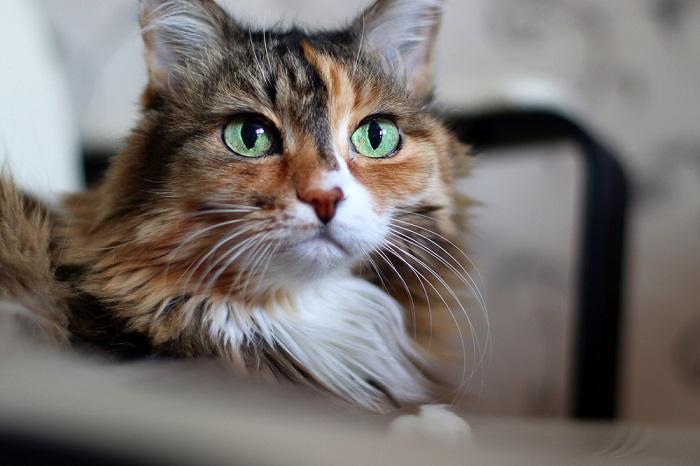
Cats that have green eyes have a little bit of melanin in their irises. They can occur in cats of any color as unlike humans, the amount of melanin in the eyes or the coat isn’t connected in cats.
This means that a cat with a dark black coat with a lot of melanin could still have green eyes with only a little melanin in the iris. Green eyes can be a normal trait in certain pedigree cats like the Egyptian Mau or the Russian Blue.
Also Read: 55 Amazing Names For Cats With Green Eyes
3. Yellow/Orange/Amber/Golden
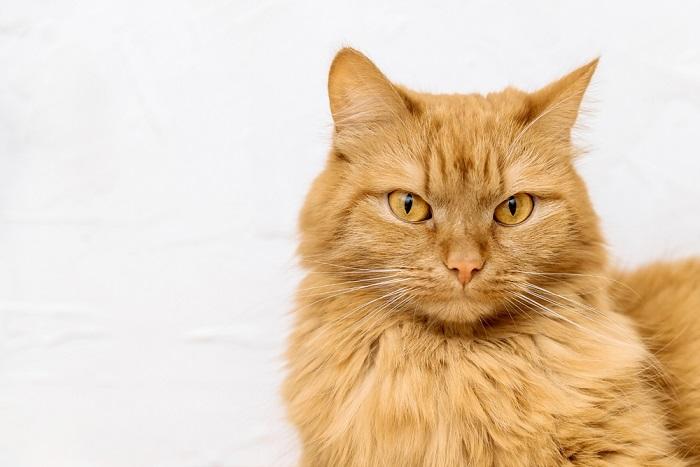
Irises that are different shades of yellow or orange have more melanin production and activity than blue and green eye colors. This can vary from a bright yellow to a deeper golden colour depending on the amount of melanin in the iris.
It’s probably one of the most common eye colors (in my opinion) and again, it can occur in cats of any color. Even though it’s the most common color, the shades can be different depending on the melanocytes and it’s a remarkable eye color.
4. Copper
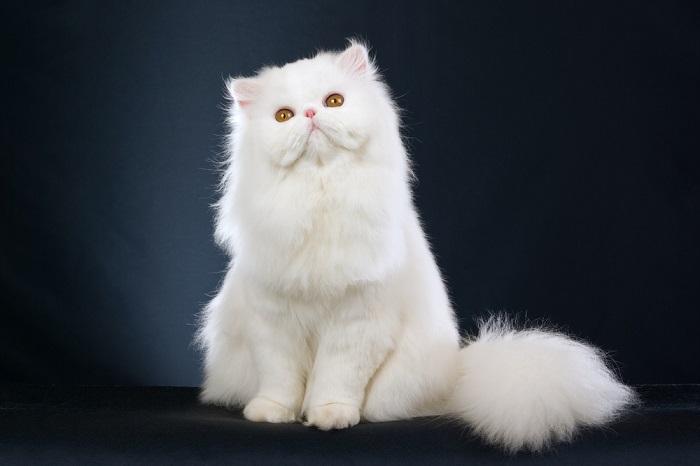
Copper is the darkest eye color that you’ll see in cats. It’s a deep orange color that can almost look like it has bits of light brown in certain lights. It’s a rare color and quite striking when seen. It may be seen in some British Shorthair cats.
5. Different Colored Eyes

Have you ever seen a cat with two different colored eyes? It’s called complete heterochromia and it can occur in any cat but particularly cats with white coats.
It’s sometimes called odd-eyed cat. One eye may be blue while the other is yellow etc. The eyes have different amounts of melanin in their two irises. It’s more common in white cats as it’s linked to the W white gene.
Also Read: Heterochromia In Cats: Cats With Different Colored Eyes
6. Mixed Eye Color
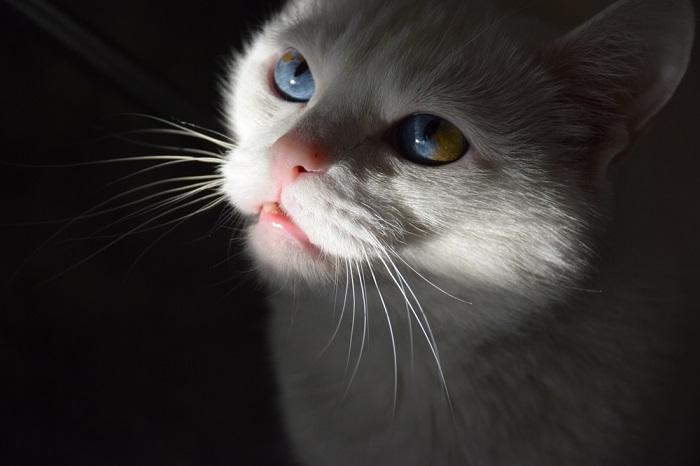
Some cats may have two different colors in the same iris e.g. a mixture of yellow and green or green and blue. This is called dichromatic – meaning two colors.
7. Red Eyes
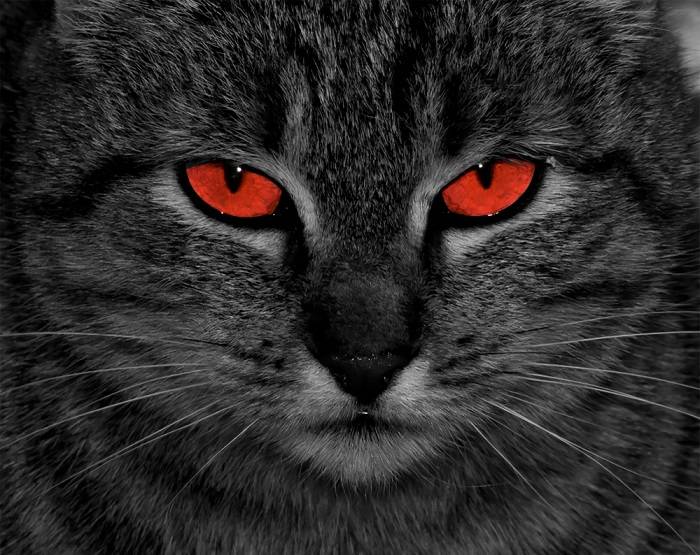
Cats don’t have visibly red eyes but in cats that have blue eyes with no melanin, their eyes will shine red when you take a photo in the dark as the light reflects off the back of the eye (tapetum lucidum). In comparison, a cat with non-blue eyes will shine luminous green/yellow when you take a photo.
Health Considerations
Although eye colors are usually harmless, there are a few things to take note of that might make certain health conditions more likely depending on eye color.
You may have heard before that white cats with blue eyes are likely to be deaf and this has some truth. Cats that have a white coat carry the W gene for white. This gene can be strongly linked to inherited congenital deafness in white cats, especially in ones with 1 or 2 blue eyes. White cats with 2 blue eyes, are 3-5 times more likely to be deaf than cats with 2 non-blue eyes. BAER testing can be done to determine deafness in cats that carry the W gene.
Cats with copper colored eyes can be normal and the eye color may be related to the breed e.g. British Shorthair. However, some cats with copper colored eyes may make your vet suspicious of a liver shunt (portosystemic shunt). There will usually be other symptoms that accompany the copper colored eyes for example; failure to thrive, vomiting, diarrhea, weight loss, disorientation and seizures. If you think your cat has any of these symptoms please make an appointment with your veterinarian.
Is Eye Color Related To Coat Color?
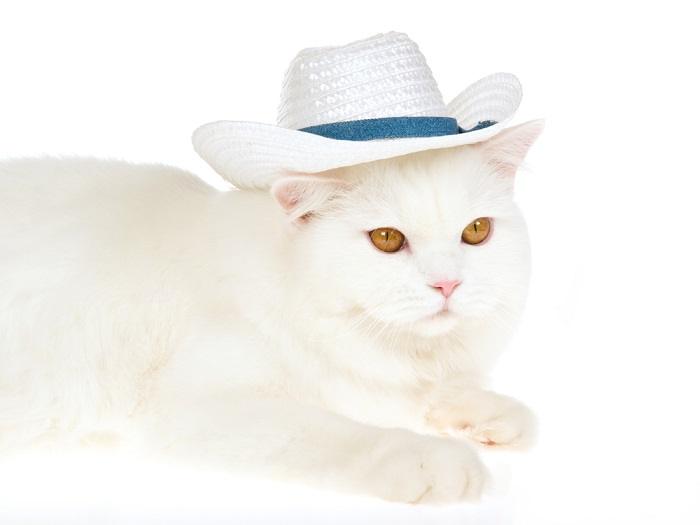
Even though melanin is responsible for both coat color and eye color, these don’t necessarily correspond in cats like they do in humans. This means that a cat with a dark colored coat e.g. black, that has a lot of melanin could have green eyes that have little melanin.
The exception to this is in white colored cats. As we’ve discussed, these cats carry the W gene which is responsible for white coats and gives a higher chance of having blue eyes. In this case, white colored coats are linked to blue eyes and deafness.
Do Cats Eyes Change Color?
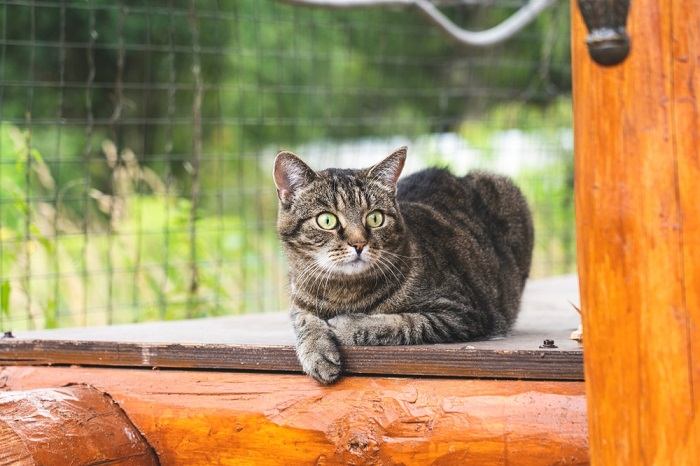
As we know, kittens are born with blue eyes and they change colors around 6 weeks of age until 3-4 months old when they adapt to their permanent color. Any color change after this age, wouldn’t be normal and may be an indication of a problem.
A sudden color change in one or both eyes may be a sign of a medical problem that needs urgent veterinary attention. This may be caused by trauma, viral or bacterial infections, systemic causes or tumours of the eye.
Traumatic, viral and bacterial causes may cause cloudiness on the eye (due to inflammation, ulcers etc.), a red appearance to the eye (bleeding into the eye from trauma – hyphema, uveitis) or focal areas of irritation (infections, ulcers etc.). An eye that appears completely cloudy or white may indicate increased intraocular pressure (glaucoma).
Systemic causes can be diabetic cataracts, high blood pressure causing severe pupil dilation and even blindness (retinal detachment) and viral causes (FIP).
Tumours of the eye can occur in the whole eye causing potential enlargement or deformity of the eyeball or in certain parts of the eye e.g. melanoma which occurs as color change in the iris.
The scope of eye issues that cats can get is another article in itself, but essentially if your cat develops any colour change in the iris or eyeball, any size change in the pupils (or different sized pupils), any enlargement of the eyeball, ocular discharges or ocular pain I would definitely recommend to get your cat checked out by your veterinarian.
It’s normal to have different eye colors after six weeks of age in a kitten, but a color change in an adult cat isn’t normal and should be examined by your vet.
Also Read: Cat Digestive System: Anatomy, Diseases, & Treatment
